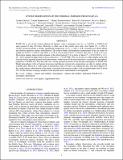Files in this item
Spitzer observations of the thermal emission from WASP-43b
Item metadata
| dc.contributor.author | Blecic, Jasmina | |
| dc.contributor.author | Harrington, Joseph | |
| dc.contributor.author | Madhusudhan, Nikku | |
| dc.contributor.author | Stevenson, Kevin B. | |
| dc.contributor.author | Hardy, Ryan A. | |
| dc.contributor.author | Cubillos, Patricio E. | |
| dc.contributor.author | Hardin, Matthew | |
| dc.contributor.author | Bowman, Oliver | |
| dc.contributor.author | Nymeyer, Sarah | |
| dc.contributor.author | Anderson, David R. | |
| dc.contributor.author | Hellier, Coel | |
| dc.contributor.author | Smith, Alexis M. S. | |
| dc.contributor.author | Collier Cameron, Andrew | |
| dc.date.accessioned | 2014-09-02T09:01:01Z | |
| dc.date.available | 2014-09-02T09:01:01Z | |
| dc.date.issued | 2014-02-01 | |
| dc.identifier | 109776123 | |
| dc.identifier | b9c0aead-bea0-452f-aa49-53c2d2da2755 | |
| dc.identifier | 84892706654 | |
| dc.identifier | 000331171200060 | |
| dc.identifier.citation | Blecic , J , Harrington , J , Madhusudhan , N , Stevenson , K B , Hardy , R A , Cubillos , P E , Hardin , M , Bowman , O , Nymeyer , S , Anderson , D R , Hellier , C , Smith , A M S & Collier Cameron , A 2014 , ' Spitzer observations of the thermal emission from WASP-43b ' , Astrophysical Journal , vol. 781 , no. 2 , 116 . https://doi.org/10.1088/0004-637X/781/2/116 | en |
| dc.identifier.issn | 0004-637X | |
| dc.identifier.other | BibCode: 2014ApJ...781..116B | |
| dc.identifier.other | ORCID: /0000-0002-8863-7828/work/58531418 | |
| dc.identifier.uri | https://hdl.handle.net/10023/5314 | |
| dc.description | Support for this work was provided by NASA through an award issued by JPL/Caltech; through the Science Mission Directorate's Planetary Atmospheres Program, grant NNX12AI69G; Astrophysics Data Analysis Program, grant NNX13AF38G; and by NASA Headquarters under the NASA Earth and Space Science Fellowship Program, grant NNX12AL83H. N.M. acknowledges support from the Yale Center for Astronomy and Astrophysics through the YCAA postdoctoral Fellowship. | en |
| dc.description.abstract | WASP-43b is one of the closest-orbiting hot Jupiters, with a semimajor axis of a = 0.01526 ± 0.00018 AU and a period of only 0.81 days.However, it orbits one of the coolest stars with a hot Jupiter (T* = 4520 ± 120 K), giving the planet a modest equilibrium temperature of Teq = 1440 ± 40 K,assuming zero Bond albedo and uniform planetary energy redistribution.The eclipse depths and brightness temperatures from our jointly fit model are 0.347% ± 0.013% and 1670 ± 23 K at 3.6 μm and0.382% ± 0.015% and 1514 ± 25 K at 4.5 μm. The eclipse timings improved the estimate of the orbital period, P, by a factor of three (P = 0.81347436 ± 1.4 × 10-7 days) and put an upper limit on the eccentricity (e =0.010+0.010-0.007). We use our Spitzer eclipse depths along with four previously reported ground-based photometric observations in the near-infrared to constrain the atmospheric properties of WASP-43b. The data rule out a strong thermal inversion in the dayside atmosphere of WASP-43b. Model atmospheres with no thermal inversions and fiducial oxygen-rich compositions are able to explain all the available data.However, a wide range of metallicities and C/O ratios can explain the data. The data suggest low day-night energy redistribution in the planet, consistent with previous studies, with a nominal upper limit of about 35% for the fraction of energy incident on the dayside that is redistributed to the nightside. | |
| dc.format.extent | 11 | |
| dc.format.extent | 1233472 | |
| dc.language.iso | eng | |
| dc.relation.ispartof | Astrophysical Journal | en |
| dc.subject | Eclipses | en |
| dc.subject | Planets and satellites: atmospheres | en |
| dc.subject | Planets and satellites: individual: WASP-43b | en |
| dc.subject | Techniques: photometric | en |
| dc.subject | QB Astronomy | en |
| dc.subject | QC Physics | en |
| dc.subject.lcc | QB | en |
| dc.subject.lcc | QC | en |
| dc.title | Spitzer observations of the thermal emission from WASP-43b | en |
| dc.type | Journal article | en |
| dc.contributor.sponsor | Science & Technology Facilities Council | en |
| dc.contributor.sponsor | Science & Technology Facilities Council | en |
| dc.contributor.sponsor | PPARC - Now STFC | en |
| dc.contributor.sponsor | Science & Technology Facilities Council | en |
| dc.contributor.sponsor | Science & Technology Facilities Council | en |
| dc.contributor.institution | University of St Andrews. School of Physics and Astronomy | en |
| dc.identifier.doi | 10.1088/0004-637X/781/2/116 | |
| dc.description.status | Peer reviewed | en |
| dc.identifier.grantnumber | ST/J001651/1 | en |
| dc.identifier.grantnumber | ST/I000666/1 | en |
| dc.identifier.grantnumber | PP/D000890/1 | en |
| dc.identifier.grantnumber | ST/G001006/1 | en |
| dc.identifier.grantnumber | PP/F000065/1 | en |
This item appears in the following Collection(s)
Items in the St Andrews Research Repository are protected by copyright, with all rights reserved, unless otherwise indicated.

